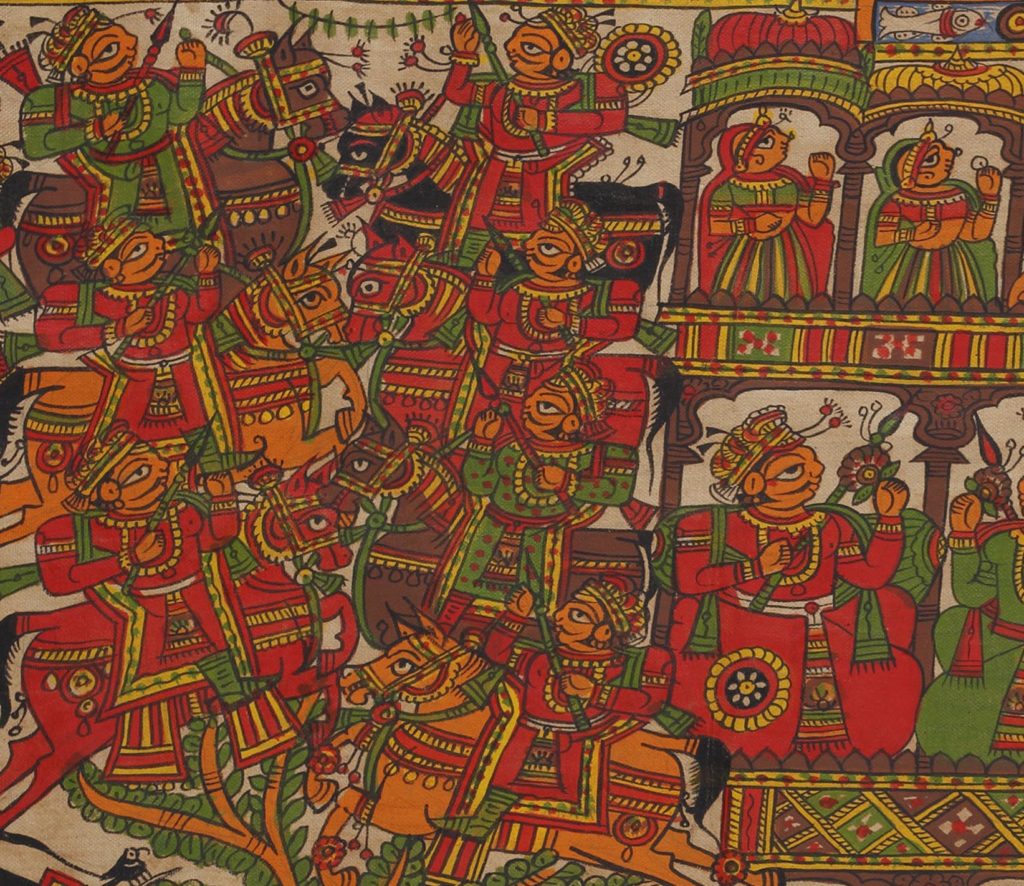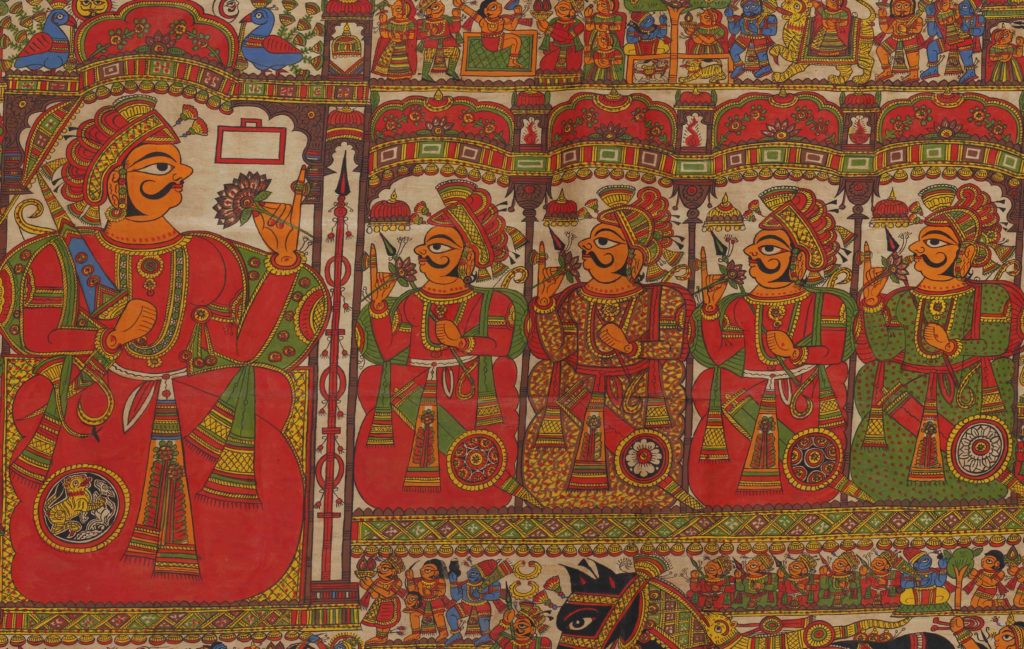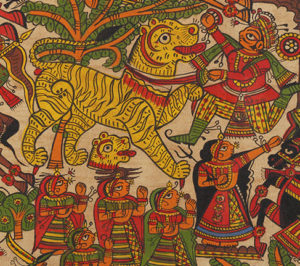
Pabuji ni phad by Shrilal Joshi ©️Sarmaya Arts Foundation
The beautiful, complex and intricate art of phad painting, believed to have begun 700 years ago, is still celebrated as a living tradition in south-west Rajasthan, especially in the Bhilwara district. The art is also found in parts of Punjab and Sindh. The artists, predominantly from the Joshi family of Bhilwara and Shahpura, believe the form has existed for a hundred thousand years. The paintings are not made for art’s sake, but to serve as ‘portable temples’ to the two deities of the Rebari tribe.
Devnarayan and Pabuji were local heroes who lived in the 10th and the 13th centuries, respectively. As leaders of a largely pastoral tribe, they came to acquire a mythical status for their ability to protect the community’s most prized possession: their animals, particularly cows and camels. Soon they became demigods, regarded as incarnations of Lord Vishnu. With this, the stories of their lives came to be infused with an element of magic.
While their gods grew in stature, the Rebaris still inhabited the margins of society. As a nomadic tribe, it’s not surprising that their shrines too were moveable. But the need for a portable temple was underscored by caste tensions. Brahmins refused to grant legitimacy to folk deities like Pabuji, necessitating a kind of ritual that could be performed on the move.
A ‘bhopo’ or priest takes the phad and travels from village to village, singing about the epics. The narration of the phad is a long performance lasting anywhere from 9-12 hours, it is performed by a pair or a trio. The bhopo is accompanied by his wife/sister-in-law (bhopis) or his brother—all-male performances are not uncommon. The Phad of Devnarayan, specifically, doesn’t have female singers at all. While the phads of Pabuji and Devnarayan might appear alike on the surface, there are subtle distinctions. For starters, there’s size. Scrolls dedicated to Pabuji tend to measure on average about 15 feet by 5 feet, whereas Devnarayan’s is bigger at 30 feet by 5 feet.
Pabuji ki Phad is the more popular of the two. The reading of it—the ‘Pabuji ri phad vanco’—starts after sunset and goes on all night in a jagran performance. The epics are never recited in their entirety; it would take 36 straight hours to tell Pabuji’s story in full. As it is, the bhopo skips certain episodes or he may ask for the audience’s preference. There are small intervals between performances for food, tea, tobacco etc. The audience may make donations in cash or kind during the performance. Every time a donation is made, the conch shell is blown and the name of the person and the specifics of their donation are announced.

The gods from left to right: Ganesha, Saraswati, Varah avatar, Krishna, Laxman, Ram, Sita, Hanuman
The bhopo incorporates hymns to gods like Ganesha, Saraswati, Hanuman and Ram in each performance. This might happen at the start, as is the case with Devnarayan ki phad or in the middle of the story. In Pabuji ki phad, for instance, the gods are invoked in an invitation to the hero’s wedding.
With a lamp, the bhopi lights up sections of the phad as the bhopa sings his way around them. This is where things get interesting. Phads are scroll paintings but unlike most others of this kind, they don’t depict scenes in a chronological, linear pattern. Even for someone who knows the epic, it can be challenging to follow the logic that guides the placement of the figures on a phad. The only rule is that the protagonist looms over all the other characters. So the largest image you see on a painting will be either Pabuji or Devnarayan. The phad also works on the principle of ‘horror vacui’—the art abhors a vacuum and totally unconnected episodes might look like they’re merging into each other or happening consecutively. A phad is highly directional. Place gets primacy over time.
According to John D Smith, a Cambridge University professor and author of The Epic of Pabuji, this deity’s phad is divided up by the places/towns mentioned in the epic. In the centre is Kolu, Pabuji’s court. Around his court are the courts of allies: on the upper left is Buro’s court (his brother), further left is Umarkot (his in-laws’ town), and then on the right, we have Deval’s court (who gifted him his mare, Kesar Kalami), Harmal’s (his courtier’s) mother’s home and on the top right is the region of Sambhar and towards the middle right is Pushkar. On the extreme left and right corners are Lanka and the court of Jindrav Kinchi, both enemies of Pabuji.

On the right is the end of Buro’s court marked by the pavilion. On the left is Pabuji being welcomed by his in-laws
In the above scene, you’ll notice Pabuji has arrived in Umarkot for his wedding, riding in with his courtiers. Prithvimal Sadho (his father-in-law) and his courtiers are coming from the left to welcome him. The scene takes place right beside Buro’s court, as if to imply that Umarkot is only around the corner from Kolu. This may have been an improvisation by the artist to fit the plot into a small space. So the end of Buro’s territory is marked by the edge of the pavilion, once again underlining the essential elasticity of the arrangement.

The primary characters who reappear in multiple scenes: Pabuji and his courtiers, Chado, Dhembo and Harmal
Due to the horror vacui nature of the painting, the images are often ambiguous and used interchangeably in multiple episodes. For example, the central image of Pabuji and his courtiers is used when Pabuji is introduced in the first three verses and later, when he returns to his court from Umarkot after his wedding.
Iconographically, Pabuji and his three main courtiers can be identified as follows: Pabuji wears red and rides a black mare (the magical Kesar Kalami), Chado wears red too and rides a red horse, Dhembo wears green and rides a red horse with brown spots, and Harmal wears red and has a tan-coloured horse. Any other courtier whose names are unknown or vary with each folk tale are dressed in red with green spots. The characters face each other instead of facing the audience.

The same tiger appears twice, the second time in the form of a severed head
The phad sometimes also illustrates a particular scene in progression. The scene above is Dhembo slaying a tiger. This single scene is depicted twice: as Dhembo is severing the tiger’s head, and then, right below, as the tiger’s head falls to the ground.
Traditionally, both the bhopos and the Joshis taught their art to their sons and daughters-in-law so it would remain in the family. The Joshis claim that their ancestors were commissioned by Chochu Bhat, a devotee of Devnarayan, to make the first-ever phad. While the bhopas still pass on the oral tradition from father to son, the Joshis have begun teaching the art to students outside the family. Fifty years ago, Shrilal Joshi, one of the most prominent phad painters in the country, opened a school called Joshi Kala Kunj or Chitrashala in the city of Bhilwara. While the school is still operational, not many of its students go on to make a career with this art form. The founder’s son Kalyan Joshi has introduced new styles and formats within the genre to keep the tradition and the culture it represents alive.
Kuhu Kopariha is an intern with Sarmaya with a keen interest in unravelling the mysteries of phad paintings
BIBLIOGRAPHY:
- The History of Phad Paintings & Phad Painters by Phadchitrakari.com
- VIDEO: Welcome to the World of Phad Paintings by Kalyan Joshi
- The Epic of Pabuji ki par in performance by Elizabeth Wickett
- The Epic of Pabuji
- Phad paintings: Rajasthan’s travelling temples are fading away after half a millennium
- Exploring the alternative faith through Pabuji: The folk deity of Rajasthan
- Nomadic Narratives: A History of Mobility and Identity in the Great Indian Desert by Tanuja Kothiyal
- Nectar Gaze and Poison Breath: An Analysis and Translation of the Rajasthani Oral Narrative of Devnarayan by Aditya Malik



